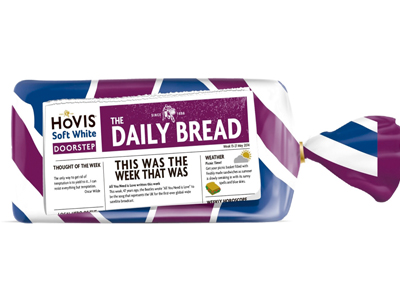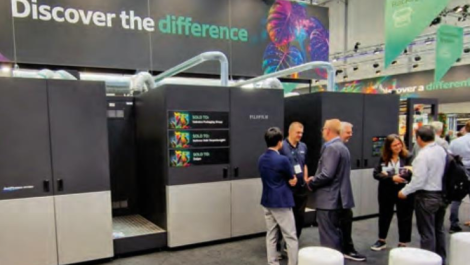The impact created by the recent Share a Coke in-store customisation campaigns has arguably done more to profile the marketing potential that digital print offers to brands than even the electrifying of Benny Landa’s presentations. Des King takes soundings from across the supply chain on the technology’s immediate prospects.

Douglas Hutt
Manager: global packaging
SABMiller
Lynn Harris
Account director digital
jkr
Andrew Scrimgeour
Managing director
AJS Labels
Stefan Casey
Business innovation manager
The Retail Institute
What are the most important benefits that digital print technology brings to the production of labels and packaging?
Digital is not about reducing costs, it’s about adding value not least in its ability to deliver messaging on a one to one basis. The digital printing of labels and flexibles has grown exponentially and that’s been fantastic in terms of management of stock, deployment of working capital, having to produce minimal order quantities on-demand and so being able to have exactly what you want when and where you want it. Those are big, big benefits, but when it comes to secondary and tertiary packaging, the application of the technology is lightyears behind.
Digital print enables us to approach creative opportunities a bit differently and to see pack as media. By using packaging to create a campaign, we can develop a more compelling form of advertising than traditional mediums. On shelf, we can better flex our creative outputs to be bolder, more characterful and to create more in-store disruption. We can experiment with how we use brand assets and pack formats to bring brand character to life. We like tangible, personal objects in the hand, and if you can link traditional advertising to the experience you’re having with the product, then you have created a very desirable piece of packaging and added value to a brand’s overall proposition.
The most important benefits include theability to produce short runs economically and to offer quick turnaround as well as allowing for ‘postponement’, ensuring reduced obsolescence and reduced waste. There are fewer processes involved, ie no films, plates or screens further reducing costs. Depending on type of digital printing we would argue for example that our machines give better quality print, better registration and more colour consistency along and across the web. There are many reasons for this, including better control processes built in, better computer controls, but also because they are housed in air-conditioned cleanroom environments.
The ability to develop personalised and customisable applications means that marketing and brand teams, and creative agencies need no longer be at loggerheads with production and suffer ‘print constraints or volumes’. Digital jobs can be run and looped seamlessly. They will be quicker and more agile but will also reduce wastage for instance allowing the print of single language or being flexible to have variables in volumes for seasonal promotions. In short, digital brings us creativity, speed, and waste and cost reduction.
How do you rate the capability for customisation in relation to the other attributes that digital print brings to the brand proposition?
I’d rate it very highly; likewise the attributes and the relevance that it brings, especially in print quality which is very much challenging analogue. A lot of FMCG companies are set up for high speed production, and in this economic climate, cost-effective efficiencies therein have become more and more important in delivering consumers the ongoing value that they require. The ability to have an agile manufacturing environment that produces a standard product that can then be highly differentiated at the latest possible stage in the process gives the brand owner the ability to touch both ends of the spectrum.
Digital print has been used on labels for more than a decade, so the ability to overprint variable data is nothing new. Short runs and launches have also benefitted from digital print for quite a while now. The way we’re using the medium to tell more impactful brand stories, how we’re using the entire canvas for variable design, is game changing for brands to be more expressive and personal. To be able to change copy on back of pack is not new to be able to have more relevant, more personal conversations with consumers through a brand’s main asset, it’s packaging, is where exciting potential lies.
For many brands, customisation allowing for personalisation is the key attribute of digital and would outweigh all the other attributes. From a marketer’s point of view cleverly executed personalisation can have the greatest leverage on the success of a campaign.
With regard to capability for customisation, I think the various digital technologies do vary so that could affect the outcome. HP with its Smart Stream does have a highly advanced piece of software that allows us to personalise just about everything on a label including the code, the text and the image, so that definitely enhances the rating.
With newer digital print machines coming on-line this year, and unique direct to product digital printing being successfully piloted the capabilities will truly be endless. The creative freedom with which brands and retailers will be able to respond quickly will become more commonplace, for example, the Irn-Bru response to the Share a Coke campaign. In a world where we are just one tweet away from the next big craze, brands could capitalise big time.
Has the success of the Share a Coke campaign advanced or obscured the contribution that is/can be made by those other benefits?
It has showcased what can happen when you use a very simple application of digital. The ‘wow’ impact, the huge theatre that it created not just in store but in the hand and online, it was all of significant value to open that door into the development kitchen in terms of the future of digital and what that will deliver for branded packaging. I’ve struggled with the digital print industry for a few years now, because they look on a technology push rather than a consumer pull. Against the backdrop of the economic downturn, a lot of converters have put R&D on hold pending the return of growth, so they need a strong business case to invest in the future of digital.
The campaign cleverly mixed digital and traditional print and mass, individualised distribution. This shows that with an innovative approach and the right planning, digital print can easily sit alongside and merge with existing processes. It helps us to see digital print as an enabling tool rather than an expensive or new tool. It also showed that, even though the cost was higher than traditional print, the return on investment was worth it. This is a change of mindset that we need to start getting used to and start finding budgets from not just packaging spend, but from bigger media spend.
I think the Share a Coke campaign has raised the awareness of what personalisation, or versioning, can do and the future I am sure will be about personalising your offering; that is the essence of true marketing after all. I actually am surprised that more brands haven’t yet done more with this, but then there is always some reluctance amongst marketers to be seen to be just a follower. That said there are lots of creative opportunities for personalisation that don’t need to be like the Share a Coke campaign. Come and talk to me!
Share a Coke is simply an example (albeit the first to market successfully) of the creative and consumer engagement digital print can reach, but I wouldn’t say it overshadows the other benefits. Coke simply had a clear strategy to exploit the commercial gains it got from the campaign. There are many more unique and better examples these days that take this technology further, but for it to be taken seriously we must underline the functional and time/cost saving benefits it can bring. Let’s not forget that print is only part of the experience. To truly win over the consumer each and every touch point needs to be considered. Having a great creative idea or campaign is only part of the battle.
Do you see the greatest potential future for customisation and/or personalisation in-store or via online shopping/transit packaging?
The FMCG companies should be more proactive in going out and talking to the packaging industry; and the packaging industry should be addressing those issues and coming up with solutions. Companies like Nike and Adidas all have sections on their websites where you can select a standard trainer and then personalise the hell out of it. That sets a level of expectation that’ll permeate into every single facet of shopping online for both high value and mainstream products, but in different ways. Consumers view the ‘first moment of truth’ on the shelf in reverse order from tertiary to primary pack. In order to have a successfully customised campaign, there’s little point in printing a primary pack digitally, to then hide it behind analogue secondary and tertiary packaging on shelf in store. The consumer will just walk on by.
In the near future, in-store uplift is more realistic, but in the medium future I hope we’ll have an interesting mixture of both. While our habits and behaviours are dramatically changing due to omni-channel shopping, we’re not quite ready for every piece of shipped packaging to have a bespoke design. Current print and distribution channels aren’t quite fluid enough just yet, but opportunities to innovate are being opened up by our need for personal experiences and ever increasing use of gadgets. All we need to do is look at how the back end of the publishing industry has evolved to meet/create consumer habits, where now it’s up to our immediate need state to choose between the bespoke book forms that are found in-store, on-demand or via download.
Well the big volume versioning campaigns like Share a Coke will be store based but the most exciting growth will come from online channels such as the personalised cards and personalised goods. This will just grow and grow.
<Personalised champagne>Personalised champagne label from AJS Labels
Gifting is where the most lucrative potential for customisation and personalisation will be seen in the short term, for example, digital print solutions for Nutella at Selfridges causing chaos at Christmas and Easter. But as well as in store, we can also see this moving to the home as 3D printing technology becomes mainstream; personalised chocolate bars, etc. Transit packaging is now potentially the first moment of truth or ‘first experience moment’ for the consumer at home. The opportunities here have only just started to be exploited, but the rise of subscription businesses are tapping into this quickly, so should the packaging world!






